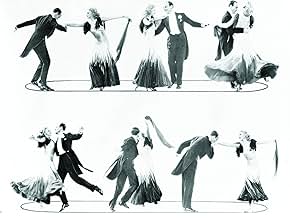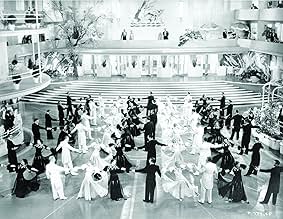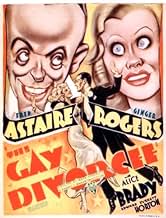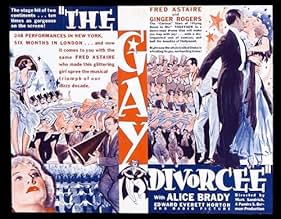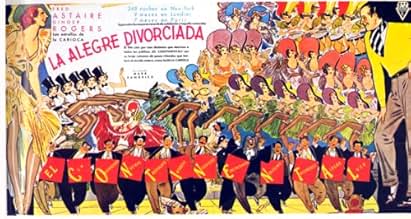Une jeune femme souhaitant divorcer simule un adultère en engageant par correspondance un homme qui se fera passer pour son amant. Elle rencontre à la douane Guy Holden, un danseur, et est p... Tout lireUne jeune femme souhaitant divorcer simule un adultère en engageant par correspondance un homme qui se fera passer pour son amant. Elle rencontre à la douane Guy Holden, un danseur, et est persuadée qu'il s'agit de son homme de paille.Une jeune femme souhaitant divorcer simule un adultère en engageant par correspondance un homme qui se fera passer pour son amant. Elle rencontre à la douane Guy Holden, un danseur, et est persuadée qu'il s'agit de son homme de paille.
- Réalisation
- Scénario
- Casting principal
- Récompensé par 1 Oscar
- 4 victoires et 5 nominations au total
- Undetermined Role
- (non crédité)
- Undetermined Role
- (non crédité)
- Undetermined Role
- (non crédité)
- Dancer
- (non crédité)
- Chorus Girl
- (non crédité)
- Dancer
- (non crédité)
- Night Club Patron
- (non crédité)
Avis à la une
Mark Sandrich worked with Ms. Rogers and Mr. Astaire in several movies. Somehow, "The Gay Divorcée" is one of their best collaboration. This film is a lot of fun to watch, even after more than 70 years after it was made. It speaks volumes for all the people involved in the production of this movie.
The Great Depression was the right background when movies like this were made. In a way, it was an escape from the harsh realities of the times America was going through. The public went to the movies to see their favorite stars that were shown in such a glamorous roles. How could anyone not admire the great Fred Astaire, always impeccably dressed? Or how could not any woman in the theater envy Ms. Rogers's beauty and easy grace? That era made it right for Hollywood to show the world a sensitivity and sophistication that only few rich types were able to enjoy in real life, while the rest was trying to eke out a life of whatever work they could find.
The musical numbers are amazing. "The Continental" alone, must have blown the budget of the picture. Imagine how much it would cost today to have all those dancers in a sound stage! Not only that, but in that lengthy number, there are at least four changes of costumes for the women. Also, he is delightful singing "Looking for a Needle in a Haystack". A young and radiant Betty Grable makes an appearance singing "Let's K-knock K-knees" in which she shows a bit of her enormous charm and talent.
Ginger Rogers makes a gorgeous Mimmi Glassop. Alice Brady, is perfect as the dizzy Aunt Hortense. Edward Everett Horton plays an excellent Egbert Fitzgerald, the divorce lawyer. Erik Rhodes is one of the best things in the film; his Signor Tonetti injects a funny shot into the movie. Eric Blore, as the waiter, has great moments in the movie.
In setting the film in London and Brighton, a rich texture is added to this winning picture that will remain a favorite that will live forever because of the chemistry that Ginger Rogers and Fred Astaire produced in anything they did together.
Not the most original of plots, this movie teamed the leads together for the second time (the first time they led the cast though). Both are terrific, and Fred's dancing throughout is a treat. Ginger is her usual bouncy self, all wisecracks and big eyes, and good on her feet. They're ably supported by Edward Everett Horton (as 'Aunt' Egbert), Alice Brady (the towering matriach, Rogers' aunt), Eric Blore (as an irritating waiter who likes talking about rocks and playing with words), Erik Rhodes (as a daft Italian), and Betty Grable (as a hotel guest who has a terrific number with Horton, 'Let's K-knock K-knees').
As you might guess, the story revolves around a divorce, which might be a gay one (in the 1930s definition of the word, of course), and, as so often in this series, mistaken identities. Tiny roles go to William Austin (as Rogers' blustering geologist hubby), and Lilian Miles (an Alice Faye lookalike who gets to reprise 'The Continental' all to herself).
This is one of the better entries in the series, ably directed by Mark Sandrich, and featuring a mix of songs including Cole Porter's 'Night and Day', and the jaunty 'Looking for a Needle in a Haystack'.
Ginger Rogers was by far the bigger cinema star when RKO Radio teamed her with Fred. She had appeared in 34 films to his 3, and two in the previous year had been smash hits - "Golddiggers" and "42nd Street". This loose borrowing from Cole Porter's Broadway show contains only one of the master's songs, the immortal "Night And Day", and only four other songs in the entire movie - Conrad & Magidson's "Needle In A Haystack" and "The Continental", and Gordon & Revel's "Don't Let It Bother You" and "Let's K-nock K-nees" (featuring an 18-year-old Betty Grable, who had herself featured in no less than eight films in the previous year).
At the depth of the Depression, this sort of film was all the rage - a fantasy of carefree opulence and ease, set in a world of Parisian floorshows, ocean liners and tuxedos. The wit is sharp and the mood flirtatious. What if the film-makers hadn't the first clue about how an English barrister conducts his cases? This is about romance, not professional ethics. What if the terrain of Brighton isn't an igneous intrusion, but in fact a sedimentary accretion? This is about two people's sublime dancing, not geology.
Fred is as always the quintessence of style, a naturally elegant creature, and Ginger is gorgeous. The plot is very well constructed, containing all the misunderstandings associated with musical farce, but developing them with panache. The denouement is both neat and unexpected. There are plenty of girls dancing in the usual geometric patterns, but there is also abundant creativity in the choreography - the playful steps in "The Continental", for example, or Fred's reluctant dance for his supper. Mimi is trying to resist Guy, and has to be drawn into "Night And Day" against her will - an instance of character being expressed through dance. Max Steiner's arrangement of this number is glorious, with its 'tacit', and the swelling fortissimos, and a dainty countermelody in the strings. Ginger sings "The Continental" like an angel, nicely ragging the time.
Inconsequential? No doubt. Frothy? Certainly. A joy to watch? Definitely!
Actually Fred had also done Funny Face and The Bandwagon on stage as well. But on stage The Bandwagon was a revue and Funny Face had an entirely different plot than the musical made by Astaire in the Fifties. Only in The Gay Divorcée was he asked to repeat a stage role.
The basic plot is still the same, the usual Astaire-Rogers case of mistaken identity. Ginger is the budding divorcée going to London to get a divorce as Aunt Alice Brady hired a professional co-respondent. Ginger mistakes Fred for that co-respondent and it takes a while for Fred to warm her up.
Fred's an American musical comedy star visiting London with his manager Edward Everett Horton who also happens to know Brady. This gives the excuse for the musical numbers.
Cole Porter's score was cut completely from the screen other than the immortal Night and Day. In it's place came four songs, three written by Harry Revel&Mack Gordon and one written by Con Conrad&Herb Magdison. Fred and Ginger dance divinely to Night and Day.
Fred does a solo dance to A Needle in a Haystack and Don't Let It Bother You. Betty Grable got her first notice from the movie going public, singing and dancing in Let's Knock Knees all of which were contributed by Revel&Gordon.
But it was The Continental number by Con Conrad and Herbert Magdison that got the first Academy Award ever given out for Best Original Song in a motion picture. It's what The Gay Divorcée is remembered for today. It's a rather long, between ten and fifteen minutes of screen time, but as magical as ever
The Gay Divorce ran for 248 performances on Broadway during the 1932- 1933 season. Sacrificed for romance are Porter's witty lyrics in the rest of the score containing their usual commentary on the social scene. Of all the American musical giants of the era, I would say that Cole Porter wins hands down as the man that Hollywood butchered the most in bringing his work to the screen. Even before The Code was in place, it seemed that the powers that be deemed that his work was way too sophisticated and naughty to be seen and heard as is.
Still with the film being frothy romance instead of social commentary, The Gay Divorcée is still great entertainment. Also repeating their roles from Broadway are supercilious waiter Eric Blore and the real co-respondent Tonetti who prefers spaghetti, Erik Rhodes.
Wit for romance, you decide if it was a fair exchange.
Le saviez-vous
- AnecdotesThe musical number "The Continental" lasts 17 1/2 minutes, the longest number ever in a musical until Gene Kelly's 18 1/2-minute ballet at the end of Un Américain à Paris (1951) 17 years later. It is also the longest musical number in all of Fred Astaire and Ginger Rogers' films together.
- GaffesDuring the car chase, Guy makes a quick turn on a dirt road, and a sound effect of squealing tires is heard. Tires do not make a squealing noise on dirt.
- Citations
Tonetti: [unable to remember his passphrase "Chance is a fool's name for fate," Tonettie repeatedly muffs it] Chance is the foolish name for fate. / Give me a name for chance and I am a fool. / Fate is a foolish thing to take chances with. / I am a fate to take foolish chances with. / Chances are that fate is foolish. / Fate is the foolish thing. Take a chance.
- Versions alternativesIn the version of the movie released in Brazil in the 1930s, the Brazilian actor Raul Roulien sang in the musical number "The Continental".
- ConnexionsEdited into Jeanne de Paris (1942)
- Bandes originalesDon't Let It Bother You
(1934)
Music and Lyrics by Mack Gordon and Harry Revel
Dance performed by Fred Astaire
Meilleurs choix
- How long is The Gay Divorcee?Alimenté par Alexa
Détails
- Date de sortie
- Pays d’origine
- Site officiel
- Langues
- Aussi connu sous le nom de
- La alegre divorciada
- Lieux de tournage
- Santa Monica, Californie, États-Unis(Exterior)
- Société de production
- Voir plus de crédits d'entreprise sur IMDbPro
Box-office
- Budget
- 520 000 $US (estimé)
- Montant brut mondial
- 6 879 $US
- Durée1 heure 47 minutes
- Couleur
- Rapport de forme
- 1.37 : 1



